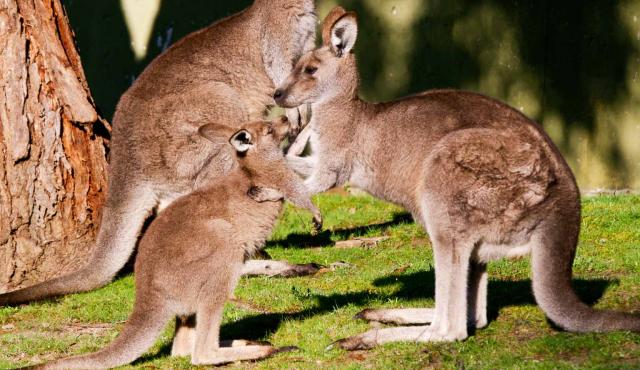A range of teacher professional learning programs will be developed to accompany the Biodiversity of the Western Volcanic Plains online outreach...





Eastern Grey Kangaroo
Macropus giganteus
Active mostly from dusk to dawn, in small or large groups (mobs). Shelters under trees or shrubs. Can breed at any time of the year but mostly in summer. Gestation takes about 36 days. The joey leaves the pouch at about 11 months of age but suckles from the mother until about 18 months old, and by then another young may be in the pouch. Kangaroos can co-exist with sheep and cattle (except for times of drought or overstocking) as they prefer different plant foods.
| Details | Description |
| Type | Mammal |
| Group | Marsupial |
| Other Common Names | Great Grey Kangaroo |
| Identifying Characteristics | |
| Distinctive Markings | Grey-brown fur, pale grey underneath. |
| Diet | Herbivore. Eats mainly grasses and herbs but sometimes leaves from trees and shrubs. Needs to drink water regularly. |
| Habitat | Wide range of habitats including grasslands, grassy woodlands and forests. Also pastures, parklands and golf courses. |
| Native Status | Native to Australia |
| Sounds | Loud, coughing alarm call. Clucking sounds between mother and young. |
| Taxonomy | |
| Phylum | Chordata |
| Class | Mammalia |
| Order | Diprotodontia |
| Family | Macropodidae |
| Genus | Macropus |
| Species | giganteus |

Distribution maps indicate current and historic locations where species have been sighted.
Source: Atlas of Living Australia
| Conservation Status | |
| DEPI Advisory List | Not listed |
| FFG Act | Not listed |
| EPBC Act | Not listed |
The conservation status of species is listed within Victoria and Australia.
The Department of Environment and Primary Industry (DEPI) Advisory List consists of non-statutory advisory lists of rare or threatened flora and fauna within Victoria.
The Flora and Fauna Guarantee Act 1988 (FFG Act) lists threatened species in Victoria. Under the Act, an Action Statement is produced for each listed species.
The Environment Protection and Biodiversity Conservation Act 1999 (EPBC Act) is the Australian Government’s key piece of environmental legislation, listing nationally threatened native species and ecological communities.



